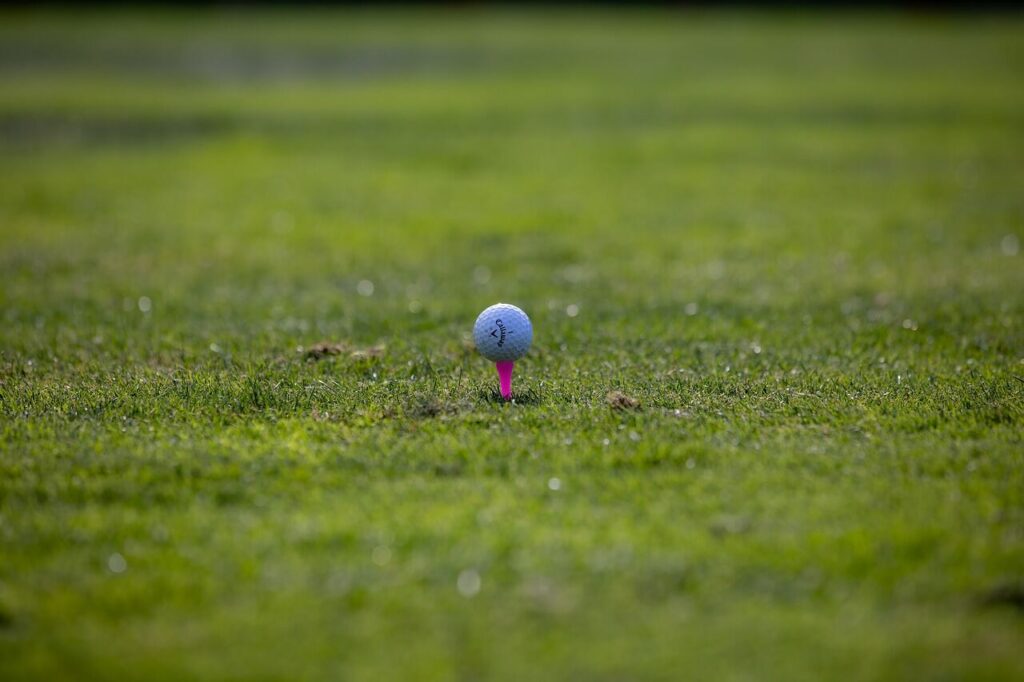A messy golf bag is more than just an eyesore—it can genuinely slow you down and throw off your rhythm on the course. The fix is refreshingly simple: organize your clubs from longest to shortest and give every accessory its own dedicated pocket. This approach not only protects your gear and balances the bag’s weight but also makes grabbing what you need completely second nature. Learning how to organize my golf bag efficiently can significantly enhance your performance and enjoyment on the course.
How to Organize My Golf Bag for Maximum Efficiency
Why Your Golf Bag Setup actually matters. Let’s be honest for a second. An organized golf bag isn’t just about looking like a serious player—it’s about playing a smarter, less frustrating game from the first tee to the 18th green.
When every club and piece of gear has a designated home, you stop wasting precious seconds fumbling around. Instead of digging for a tee or second-guessing which iron you grabbed, your mind stays locked in on your next swing. That mental clarity is a huge, often overlooked advantage out on the course. One of the keys to improving your game is learning how to organize your golf bag in a way that enhances your accessibility and focus.
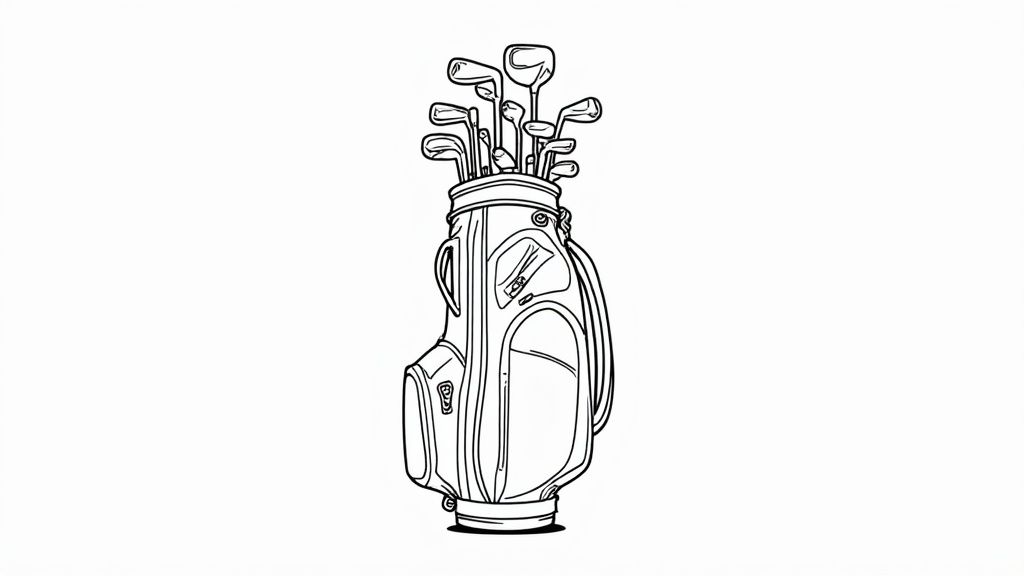
Golf: The Real-World Benefits
A logical setup does way more than just save you a few seconds here and there. Investing time in how to organize your golf bag can yield significant benefits during your rounds and getting your bag in order brings some key benefits that you’ll feel in your performance and overall enjoyment of the round. Consistency in how to organize your golf bag leads to better performance on the green.
- Club Protection: Nobody wants to see dings and scratches on their expensive clubs. Keeping longer clubs like woods and your driver separate from the irons prevents their graphite shafts from getting banged up by the steel heads of your irons.
- Improved Accessibility: The goal is to be able to reach for a club without even looking. When you can instinctively grab your 7-iron, it helps you stay in your rhythm and maintain focus between shots.
- Better Balance: A properly packed bag distributes weight evenly. This is a game-changer if you walk the course, as it cuts down on back and shoulder strain and saves your energy for those crucial final holes.
A well-organized bag is an extension of a clear mind on the course. It eliminates minor distractions, allowing you to dedicate 100% of your mental energy to strategy and execution.
Here’s a quick cheat sheet to help you visualize the most effective layout for your bag.
Quick Guide to Golf Bag Organization
| Bag Section | Clubs/Gear to Place Here | Primary Reason |
|---|---|---|
| Top (Back) | Driver, Woods, Hybrids | Protects graphite shafts and keeps the longest clubs safe |
| Middle | Mid to Long Irons (e.g., 4-iron through 7-iron) | Easy access; prevents tangling with woods or wedges |
| Bottom (Front) | Short Irons (8, 9), Wedges, Putter | Keeps most-used clubs for approach/green play accessible |
| Main Pockets | Golf Balls, Tees, Divot Tool, Ball Marker | High-frequency items need to be easy to grab |
| Side Pockets | Rain Gear, Extra Gloves, Sunscreen, Snacks | Stores less-frequently used but essential items |
| Valuables Pocket | Phone, Wallet, Keys | Soft-lined pocket for protection and security |
Following this simple system will make your time on the course smoother, letting you focus on what really matters: your game.
Arranging Your Golf Clubs for Effortless Access
Let’s get the foundation of your golf bag dialed in. We’ve all heard the simple “long clubs in the back” rule, but the real art is adapting that core idea to your specific bag, whether it’s a 4-way, 6-way, or even a 14-way divider.
The logic is simple but powerful: putting your driver and woods at the top (the section closest to the shoulder strap) is all about protection. Their longer, more delicate graphite shafts are vulnerable. Keeping them up high prevents the heavy steel heads of your irons from clanking against them, saving you from a tangled, damaged mess.
From there, you want to create a natural cascade. The goal is to make grabbing a club an instinctive, one-handed motion, not a frantic search-and-rescue mission. When you arrange your clubs from the longest fairway wood down to your shortest wedge, you create a visual and physical flow that your brain quickly learns to navigate.
Your Divider Strategy
How you execute this depends entirely on your bag’s layout. A bag with fewer dividers means you have to be a bit more disciplined in how you group clubs, whereas a 14-way divider gives every club its own private slot.
- For 4-way or 6-way dividers: Group your driver, woods, and any hybrids in one top section. The middle sections are perfect for your mid and long irons (think 4-iron through 7-iron), and the bottom sections become home for your short irons and wedges.
- For 14-way dividers: This one’s pretty straightforward. Just arrange your clubs in descending order, either left-to-right or right-to-left, whichever feels more natural to you. The longest clubs still occupy the top rows, followed by the irons, and then your wedges at the bottom.
Thinking this way helps you map out where everything should live for maximum efficiency on the course.
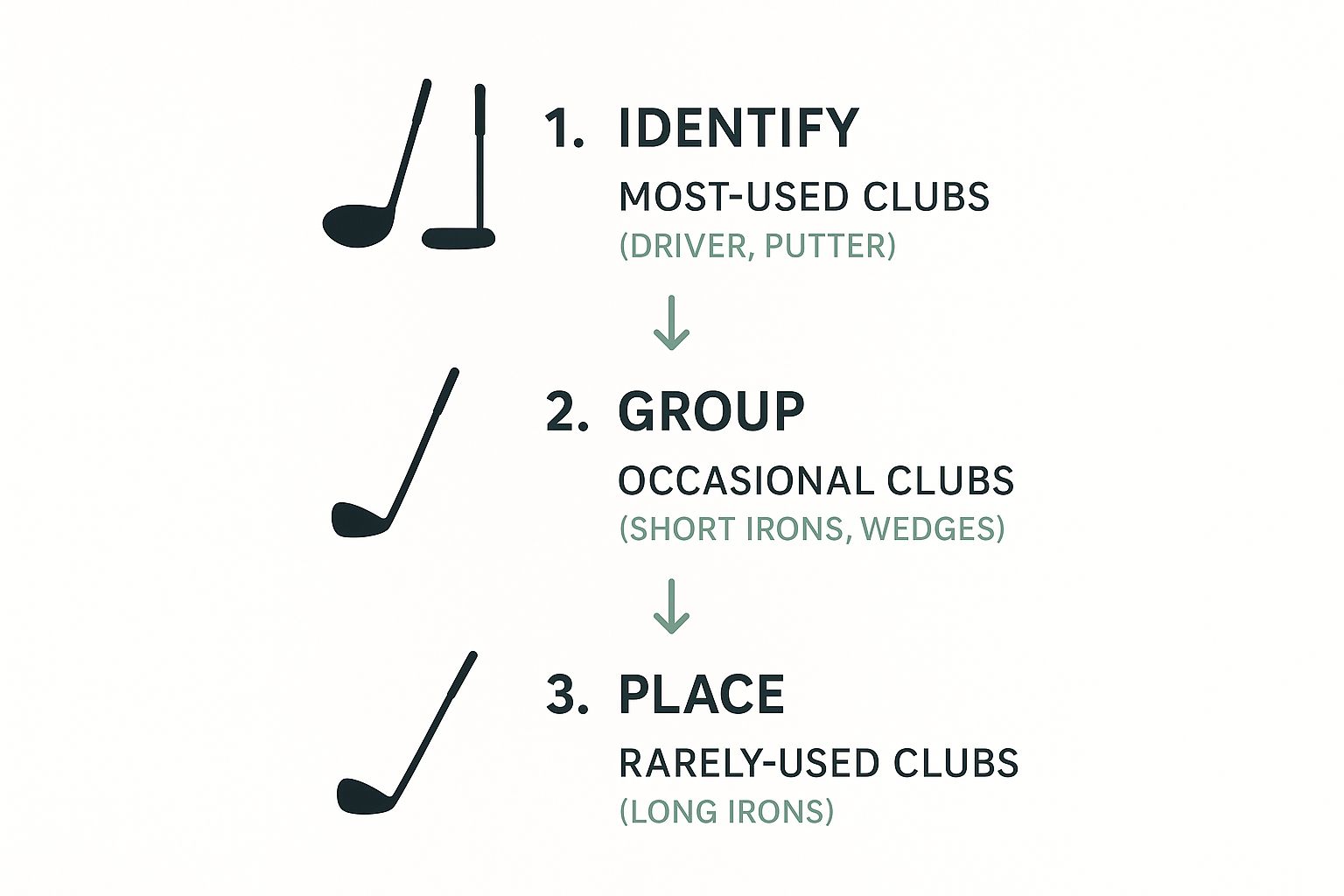
As the infographic shows, it all starts with identifying your most- and least-used clubs and then grouping everything else logically in between. Remember that how to organize your golf bag is a skill worth developing for every golfer.
Protecting the Golf Putter
So, what about the most important club in the bag? Your putter, the flatstick, deserves some special treatment. Many modern bags now come with a dedicated, oversized putter well. If you have one, always use it. This spot is specifically designed to keep the putter’s delicate head and often thicker grip safe from the chatter of your other clubs.
If your bag doesn’t have a dedicated well, the next best place is in the front-most slot, often alongside your wedges. This keeps it easily accessible and still separates it from the longer woods and irons.
The core principle is simple: assign clubs a home based on length, from longest at the top to shortest at the bottom. This method dramatically reduces the risk of club damage and makes your decision-making on the course that much faster.
In fact, some industry data suggests golfers using bags with 4 to 6 full-length dividers report a 25% improvement in club accessibility and a 10% increase in the lifespan of their gear due to better protection. You can see more trends in the golf bag market from Data Bridge Market Research. Getting this first step right is a massive part of a smooth, frustration-free round.
Mastering Your Pockets for Golf On-Course Needs
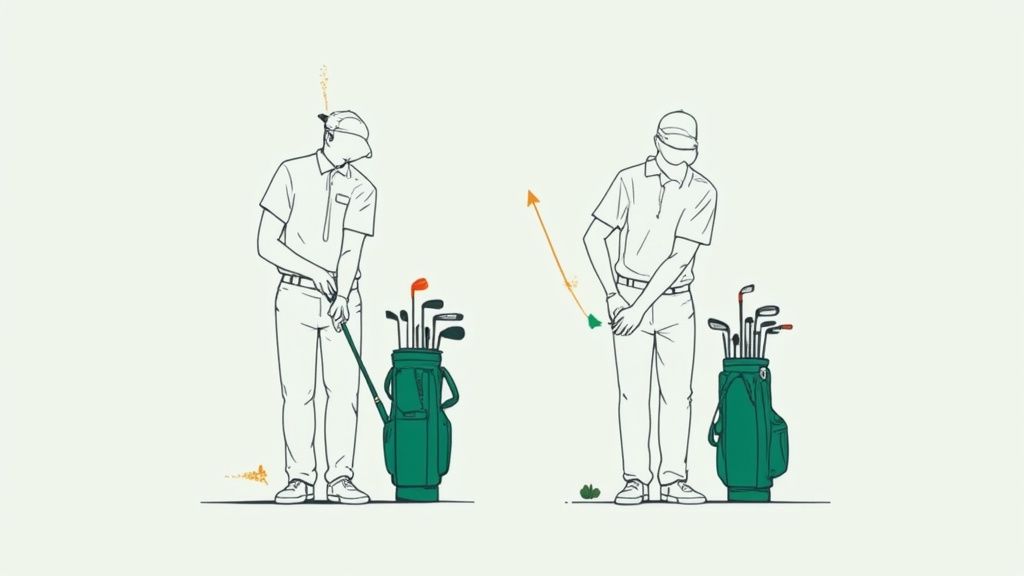
With your clubs set, it’s time to tackle the pockets. It’s all too easy to treat your bag’s storage like a junk drawer, just stuffing things wherever they might fit. The real pro move is to think of it as building a mental map for your gear, so you can grab exactly what you need without breaking your focus.
The goal here is pure muscle memory. You shouldn’t ever be fumbling for a tee when you’re standing on the tee box. Giving everything a specific, logical home turns your bag into an extension of your game, not a chaotic mess you have to fight with.
Designating Pockets for Purpose
Let’s start with the big ones. That large apparel pocket running down the side isn’t just for a polo shirt. Its real job is to hold your rain suit and a windbreaker, even on a perfectly sunny day. We’ve all been there—weather turns on a dime, and being prepared is just smart course management.
The front-most pocket, the one most people call the ball pocket, needs a bit of discipline. Fight the urge to load it up with two dozen balls; all that extra weight is just tiring you out. A sleeve or two of your go-to balls is plenty for a round. Maybe toss in a few scuffed-up ones for those daunting water shots.
Here’s a simple, logical breakdown for the rest of your essentials:
- Tees and Ball Markers: Grab one small, easy-to-reach side pocket and make it the dedicated spot for these. You’ll be reaching for them constantly, so they need to be right at your fingertips.
- Rangefinder: This piece of tech is crucial. It deserves its own pocket, usually one near the top of the bag for a quick grab before you pull a club for your approach shot. Learn more about Rangefinders here.
- Gloves and Divot Tools: Group these together in another small pocket. And trust me, having a spare glove ready to go is always a good call.
Think of your bag’s pockets like a well-organized filing cabinet. Every item has its place, making retrieval instant and thought-free. This keeps your mind clear for the only thing that matters: the next shot.
Using your specialized pockets correctly makes a huge difference. For instance, having designated spots for gloves, balls, and tees can cut your chances of losing small accessories by nearly 40%, especially when the weather gets nasty.
Finally, don’t forget about those special-purpose pockets. The velour-lined valuables pocket is the perfect safe house for your phone, keys, and wallet. And that insulated cooler pocket? It’s your best friend for keeping a drink cold through the back nine.
Balancing Your Golf Bag for an Easier Walk
If you’re someone who carries your bag or uses a push cart, balance is everything. We’ve all been there—an improperly packed bag isn’t just awkward, it’s a literal pain in the back. It can completely drain your energy long before you even make the turn at the 9th hole. Practicing how to organize your golf bag regularly ensures you never lose track of your gear.
The secret to a comfortable walk is all about weight distribution. This isn’t just about making your bag look organized; it’s about pure physics. Your main goal is to create a stable center of gravity that works with you, not against you. Realizing the significance of how to organize my golf bag can enhance your overall golfing experience.
Building a Stable Foundation
Think of your bag’s spine—that’s the part that rests against your back or gets strapped onto your cart. You want the heaviest stuff positioned low and close to this central line. This one simple strategy anchors the whole bag, stopping it from swaying around or feeling like it’s about to tip over.
Here’s how to put that into practice:
- Heavy Gear Goes Low: Your extra golf balls are basically little rocks. They’re dense and heavy, so stick them in the lowest main pocket, usually the one right at the front.
- Water Bottles: A full 32 oz water bottle adds a surprising amount of weight. Place it in a low side pocket to help keep that center of gravity down where you want it.
- Rain Gear: While not as heavy as balls, your waterproofs can be pretty bulky. Tuck them into one of the large side pockets, but try to pack them so the weight feels centered.
This setup makes for a much more stable load. If you’re walking, that means way less strain on your shoulders and back, letting the bag sit comfortably without pulling you off balance with every step.
A well-balanced bag is more than a convenience—it’s an energy conservation tool. The less effort you spend wrestling with your gear, the more energy you have for your swing.
This principle is just as crucial for push cart users. A balanced bag is far less likely to tip your cart over on a tricky sidehill lie, saving you from the classic “yard sale” of spilling your clubs and gear all over the fairway. It’s a small detail that makes a huge difference in your endurance and focus over 18 holes.
Developing Smart Golf Pre and Post-Round Habits
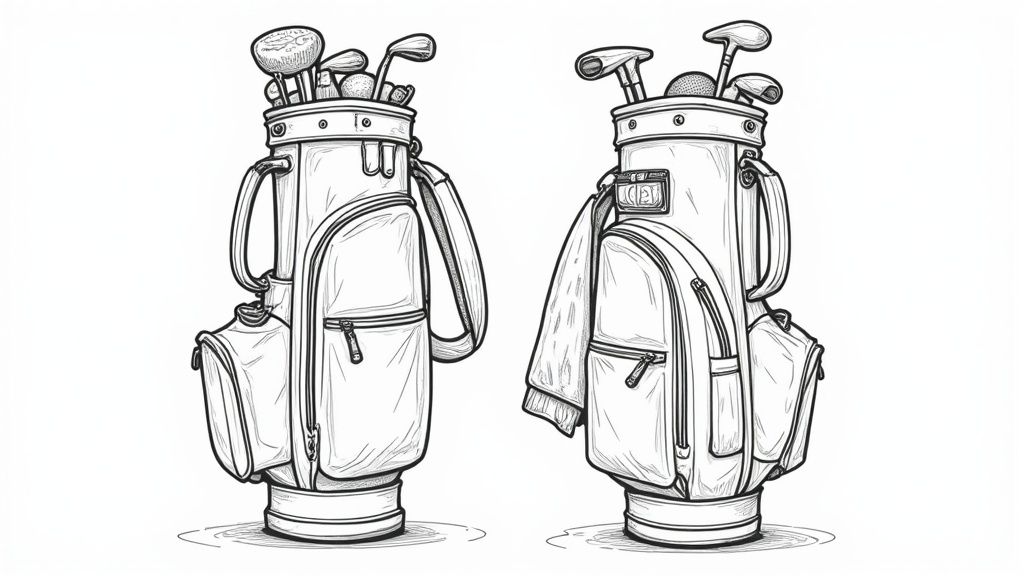
A perfectly organized golf bag is a beautiful thing, but keeping it that way is where the real magic happens. This isn’t about some massive, time-consuming overhaul. The secret is building a simple, two-minute routine that makes all the difference in the long run. As a golfer, knowing how to organize my golf bag is essential for maintaining your focus during play.
Think of it less like a chore and more like part of your golfing ritual. When you frame it this way, organization stops being a one-off project and becomes a sustainable habit. You’ll thank yourself every time you head to the course, completely avoiding that frantic pre-tee time scramble for tees or a fresh glove.
The Pre-Round Check
Before you even step out the door, take literally 60 seconds for a quick scan of your bag. This isn’t about rearranging every club. It’s just a quick inventory to make sure you’re prepared for the day ahead.
Your quick pre-round checklist might look something like this:
- Balls and Tees: Got a fresh sleeve of balls? A handful of tees? Check.
- Essential Tech: Is your rangefinder or GPS watch actually charged? Nothing worse than it dying on the 7th hole.
- Weather Gear: A quick glance at the forecast can tell you if you need to toss in that rain jacket or an extra towel.
The Post-Round Reset
This is your secret weapon for a stress-free next round. After you’ve sunk that final putt and you’re back at your car, take another 60 seconds to reset your bag. It’s hands-down the easiest way to prevent junk from piling up.
Clearing out your bag immediately after a round is the single best habit for staying organized. It ensures you start every future round with a clean slate, both physically and mentally.
Just take a moment to empty out the trash. Toss those old scorecards, snack wrappers, and that sweaty glove you peeled off on the 18th green. This simple clean-out keeps your bag fresh and ready for action.
It’s no surprise that stand bags are so popular, holding the largest market share at about 37.4% in 2023. Their divider systems are designed to keep up to 14 clubs neat and tidy. A quick reset makes sure those dividers can actually do their job. For more insights on bag trends, you can check out the analysis from Grand View Research.
Frequently Asked Questions
Even with the best system in place, you’re bound to run into a few tricky situations on the course. Let’s tackle some of the most common dilemmas golfers face when trying to keep their bags in top form.
Common On-Course Challenges
How do you handle those awkward alignment sticks? The easiest way is to slide them right down into the same divider as your driver or woods. Most bags have enough wiggle room in that top section. If not, a simple external clip can keep them secure and away from your clubheads.
Another classic is what to do with a rain jacket after a downpour. Shoving it back in the apparel pocket is a surefire way to get everything else soggy. Here’s a pro tip: toss a small, lightweight dry bag or even a large Ziploc into one of your pockets. When your rain gear is wet, stuff it in the dry bag first to contain all that moisture.
Adapting Your Setup for Different Rounds
A perfectly organized bag isn’t a static thing; it’s a flexible system that should change based on what you’re doing that day. Packing for a quick nine holes is a world away from getting ready for a week-long golf trip.
- The Quick Round: This is the time to go minimalist. One sleeve of balls is plenty. Grab a handful of tees. Leave the extra layers at home unless the forecast is truly sketchy. A lighter bag makes for a much more enjoyable walk.
- The Golf Trip: Now’s the time to maximize every inch of space. Use those shoe pockets for your golf shoes to free up your luggage. Pack extra gloves, plenty of balls, and all the weather-specific gear you might need. Think ahead—what might you need when you’re far from home?
The key is adaptability. Your bag should serve you, not the other way around. Adjust it based on the weather, the course, and the type of round you’re about to play.
As golf bags evolve, so do our organizational needs. With 15-20% of new bags featuring things like built-in USB ports and GPS holders, thinking about where to stash a power bank is the new normal. For a deeper dive into what’s new, check out the latest trends in the golf bag market. Ultimately, a great setup anticipates what you’ll need before you even realize you need it.
Here are a few more common questions we get about keeping a golf bag tidy and efficient.
| Question | Answer |
|---|---|
| How many golf balls should I carry? | For a casual round, 6-9 balls (two or three sleeves) is a safe number. If you’re playing a tournament or a very difficult course with lots of water hazards, you might want to carry 12 or more. Carrying too many just adds unnecessary weight. |
| Is there a ‘right’ way for clubs to sit in a 14-way bag? | While there’s no single “correct” way, a common and logical method is to place the driver and woods at the top (back of the bag), irons in the middle rows from longest to shortest, and wedges and the putter at the bottom (front of the bag) for easy access around the green. |
| What’s the best way to clean my golf bag? | Empty the bag completely. Use a vacuum with a brush attachment for the inside pockets and club dividers. For the exterior, mix a small amount of mild soap with warm water and use a soft brush or cloth to gently scrub away dirt. Let it air dry completely before reloading it. |
| Where should I keep my golf glove when I’m not using it? | To keep it flat and help it dry, attach the Velcro strap to the outside of your bag handle or a designated glove holder. Avoid crumpling it up and stuffing it in a pocket, as this can wear it out faster and make it stiff. |
Hopefully, this gives you a clearer picture of how to tackle those little organizational challenges that pop up during a round.
At Golf Inquirer, we believe a smarter setup leads to a more enjoyable game. For more tips, gear reviews, and course guides to elevate your experience, visit us at https://golfinquirer.com.
Learn more about Rangefinders here.



